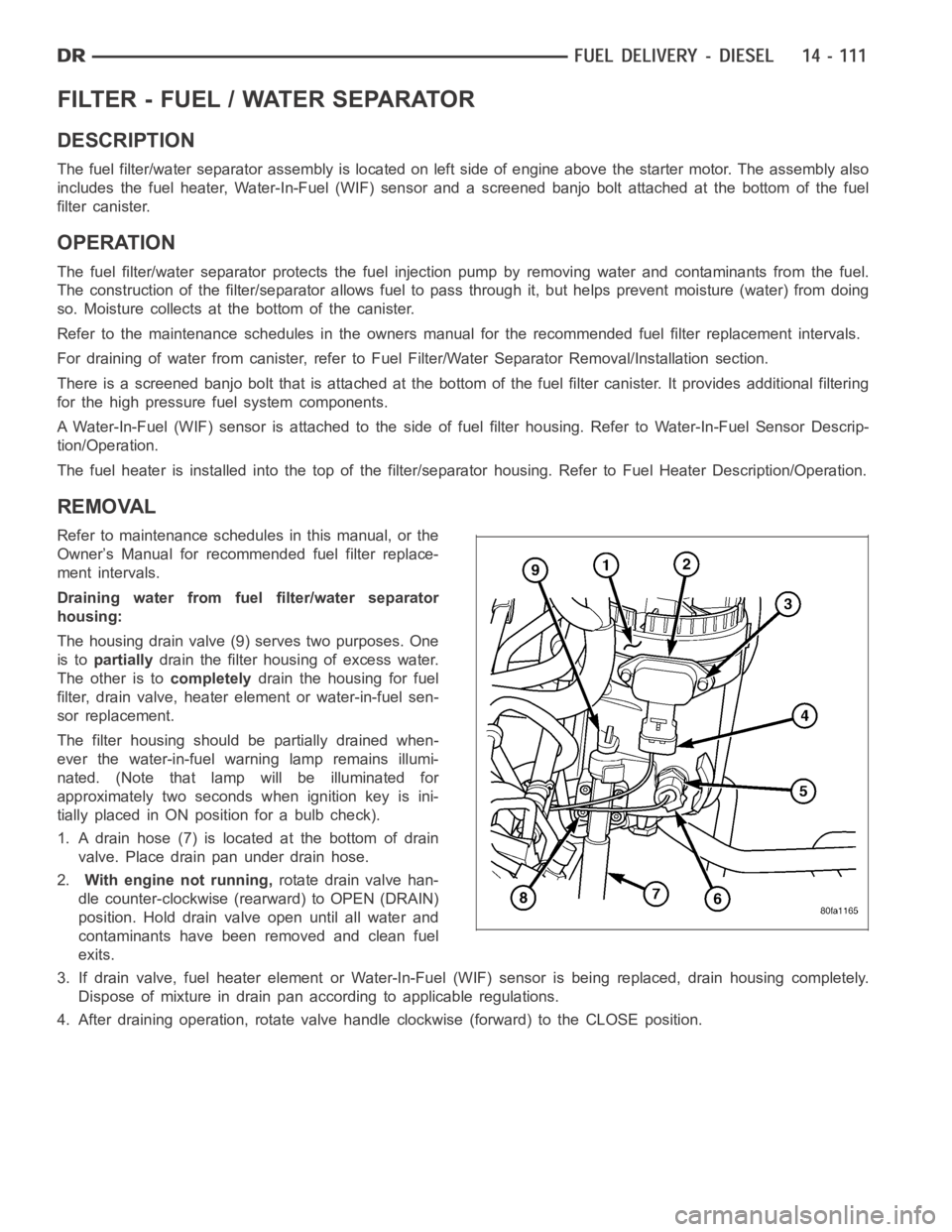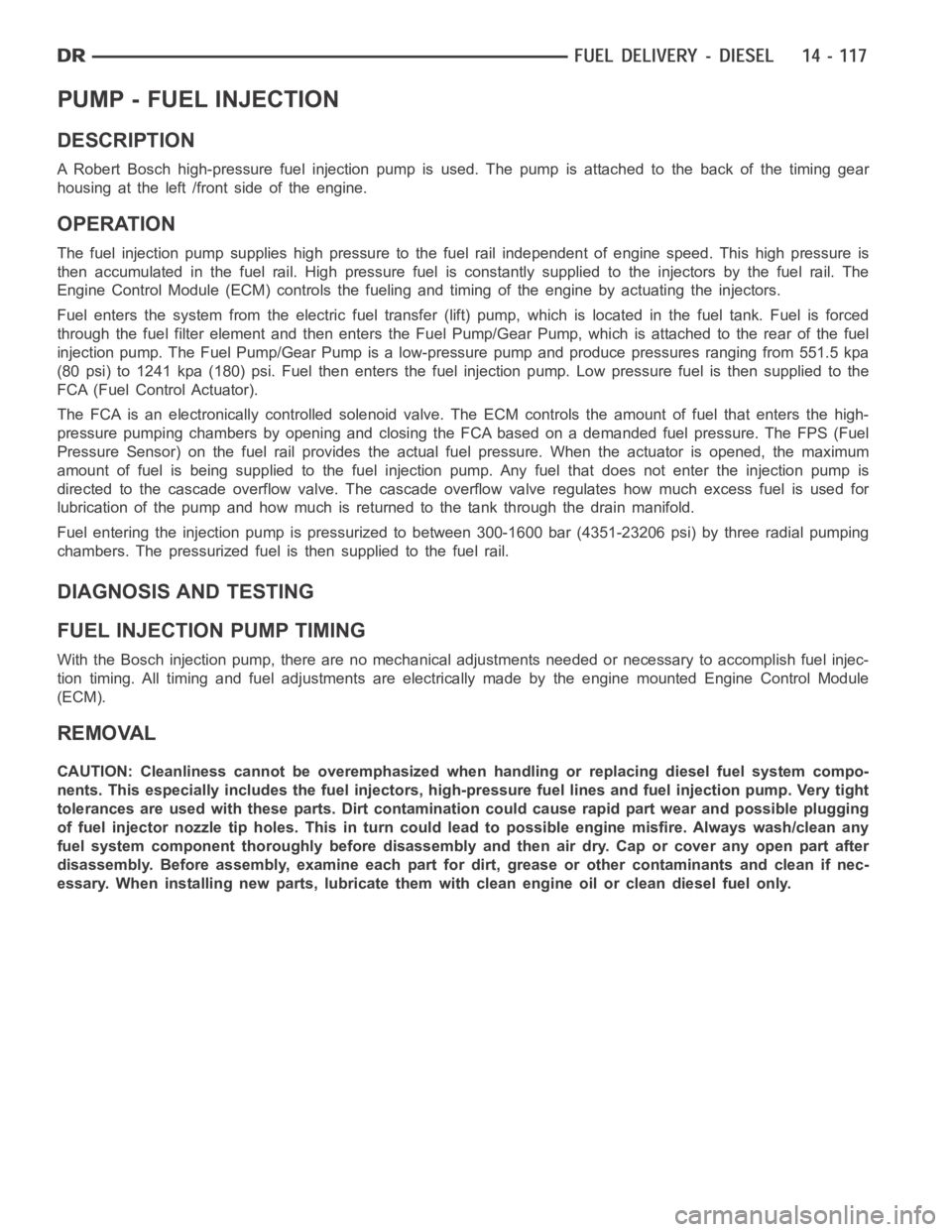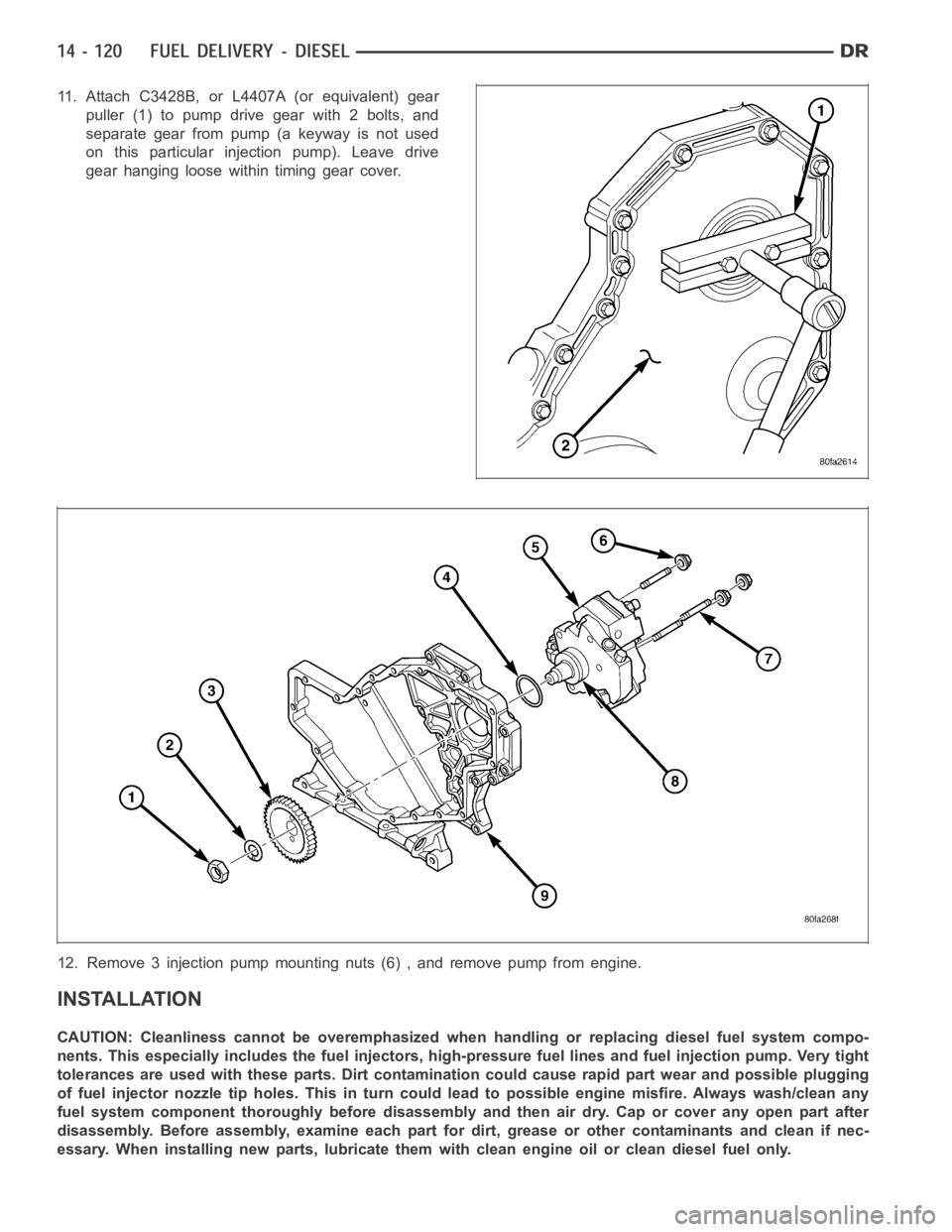Page 2345 of 5267
DESCRIPTION N-m Ft. Lbs. In. Lbs.
Fuel Line Fittings
(High-Pressure - Pump to
Rail)37 27 -
Fuel Line Fittings
(High-Pressure - Cylinder
Head to Rail)30 22 -
#6 Fuel Line Shield Bolts 43 32 -
Fuel Injector Solenoid
Nuts1.25 - 11
Fuel Injection Pump-to-
Gear Shaft Nut105 77 -
Fuel Injection Pump
Mounting Nuts24 18 -
Fuel Line Brace-to-Intake
Manifold Cover Bolt
(High-Pressure)24 18 -
Fuel Pressure Sensor 70 52 -
Fuel Pressure Limiting
Valve(BanjoBolt)24 18 -
Fuel Pressure Limiting
Valve (In Fuel Rail)70 52 -
Fuel Rail Mounting Bolts 24 18 212
Fuel Tank Mounting Straps 41 30 -
Map Sensor Mounting
Screws1- 9
ECM-to-Engine Bracket
Mounting Bolts24 18 -
ECM Electrical Harness
Connector3-27
Water-In-Fuel Sensor 4.5 - 39
Page 2348 of 5267

FILTER - FUEL / WATER SEPARATOR
DESCRIPTION
The fuel filter/water separator assembly is located on left side of engineabove the starter motor. The assembly also
includes the fuel heater, Water-In-Fuel (WIF) sensor and a screened banjobolt attached at the bottom of the fuel
filter canister.
OPERATION
The fuel filter/water separator protects the fuel injection pump by removing water and contaminants from the fuel.
The construction of the filter/separator allows fuel to pass through it, but helps prevent moisture (water) from doing
so. Moisture collects at the bottom of the canister.
Refer to the maintenance schedules in the owners manual for the recommended fuel filter replacement intervals.
For draining of water from canister, refer to Fuel Filter/Water SeparatorRemoval/Installation section.
There is a screened banjo bolt that is attached at the bottom of the fuel filter canister. It provides additional filtering
for the high pressure fuel system components.
A Water-In-Fuel (WIF) sensor is attached to the side of fuel filter housing. Refer to Water-In-Fuel Sensor Descrip-
tion/Operation.
The fuel heater is installed into the top of the filter/separator housing.Refer to Fuel Heater Description/Operation.
REMOVAL
Refer to maintenance schedules in this manual, or the
Owner’s Manual for recommended fuel filter replace-
ment intervals.
Draining water from fuel filter/water separator
housing:
The housing drain valve (9) serves two purposes. One
is topartiallydrain the filter housing of excess water.
The other is tocompletelydrain the housing for fuel
filter, drain valve, heater element or water-in-fuel sen-
sor replacement.
The filter housing should be partially drained when-
ever the water-in-fuel warning lamp remains illumi-
nated. (Note that lamp will be illuminated for
approximately two seconds when ignition key is ini-
tially placed in ON position for a bulb check).
1. A drain hose (7) is located at the bottom of drain
valve. Place drain pan under drain hose.
2.With engine not running,rotate drain valve han-
dle counter-clockwise (rearward) to OPEN (DRAIN)
position. Hold drain valve open until all water and
contaminants have been removed and clean fuel
exits.
3. If drain valve, fuel heater element or Water-In-Fuel (WIF) sensor is being replaced, drain housing completely.
Dispose of mixture in drain pan according to applicable regulations.
4. After draining operation, rotate valve handle clockwise (forward) to the CLOSE position.
Page 2350 of 5267

7.Fuel Heater Element Replacement:The heater
element (2) is located in the fuel filter housing.
a. Remove fuel filter. See previous steps.
b. Disconnect electrical connector.
c. Remove two T-15 Torx head mounting screws
(3) from fuel heater element.
d. Remove fuel heater.
8.Drain Valve Replacement:The drain valve
assembly (9) is located on the side of the fuel filter
housing.
a. Disconnect drain hose (7) from the fuel drain
valve.
b. Remove 4 drain valve mounting screws (T-15
Torx head) (8).
c. Remove drain valve from filter housing.
9. Remove the screened banjo bolt (9) that is located
on the bottom of the fuel filter housing. It attaches
the Injection Pump supply line to the fuel filter
housing.
INSTALLATION
Refer to maintenance schedules for recommended fuel filter replacement intervals.
1. Thoroughly clean inside of filter housing, filter cap and all related components.
2.Fuel Filter:
a.The engine has a self-priming low-pressure fuel system. Refer to StandardProcedures-Fuel System
Priming.
b. Install new O-ring to canister lid and lubricate O-ring with clean engine oil.
c. Position new element to canister lid. Place this assembly into canisterby rotating clockwise.
d. Tighten cap to 34 Nꞏm (25 ft. lbs.) torque. Do not overtighten cap.
3.Water-In-Fuel (WIF) Sensor:
Page 2354 of 5267

PUMP - FUEL INJECTION
DESCRIPTION
A Robert Bosch high-pressure fuel injection pump is used. The pump is attached to the back of the timing gear
housing at the left /front side of the engine.
OPERATION
The fuel injection pump supplies high pressure to the fuel rail independent of engine speed. This high pressure is
then accumulated in the fuel rail. High pressure fuel is constantly supplied to the injectors by the fuel rail. The
Engine Control Module (ECM) controls the fueling and timing of the engine by actuating the injectors.
Fuel enters the system from the electric fuel transfer (lift) pump, which is located in the fuel tank. Fuel is forced
through the fuel filter element and then enters the Fuel Pump/Gear Pump, which is attached to the rear of the fuel
injection pump. The Fuel Pump/Gear Pump is a low-pressure pump and producepressures ranging from 551.5 kpa
(80 psi) to 1241 kpa (180) psi. Fuel then enters the fuel injection pump. Lowpressure fuel is then supplied to the
FCA (Fuel Control Actuator).
The FCA is an electronically controlled solenoid valve. The ECM controls the amount of fuel that enters the high-
pressure pumping chambers by opening and closing the FCA based on a demanded fuel pressure. The FPS (Fuel
Pressure Sensor) on the fuel rail provides the actual fuel pressure. When the actuator is opened, the maximum
amount of fuel is being supplied to the fuel injection pump. Any fuel that does not enter the injection pump is
directed to the cascade overflow valve. The cascade overflow valve regulates how much excess fuel is used for
lubrication of the pump and how much is returned to the tank through the drain manifold.
Fuel entering the injection pump is pressurized to between 300-1600 bar (4351-23206 psi) by three radial pumping
chambers. The pressurized fuel is then supplied to the fuel rail.
DIAGNOSIS AND TESTING
FUEL INJECTION PUMP TIMING
With the Bosch injection pump, there are no mechanical adjustments neededor necessary to accomplish fuel injec-
tion timing. All timing and fuel adjustments are electrically made by the engine mounted Engine Control Module
(ECM).
REMOVAL
CAUTION: Cleanliness cannot be overemphasized when handling or replacingdieselfuelsystemcompo-
nents. This especially includes the fuel injectors, high-pressure fuel lines and fuel injection pump. Very tight
tolerances are used with these parts. Dirt contamination could cause rapid part wear and possible plugging
of fuel injector nozzle tip holes. This in turn could lead to possible engine misfire. Always wash/clean any
fuel system component thoroughly before disassembly and then air dry. Capor cover any open part after
disassembly. Before assembly, examine each part for dirt, grease or othercontaminants and clean if nec-
essary. When installing new parts, lubricate them with clean engine oil orclean diesel fuel only.
Page 2355 of 5267
1. Disconnect both negative battery cables at both
batteries. Cover and isolate ends of both cables.
2. Remove intake manifold air intake tube (above
injection pump) and its rubber connector hose (2).
3. Remove accessory drive belt.
4. Thoroughly clean the rear of injection pump, and
attachment points for its 3 fuel lines. Also clean the
opposite ends of these same 3 lines at their attach-
ment points.
Page 2356 of 5267
5. Disconnect Fuel Control Actuator (FCA) electrical
connector (3) at rear of injection pump.
CAUTION: Whenever a fuel line fitting is con-
nected to a secondary fitting, always use a
back-upwrenchonthesecondaryfitting.Donot
allow the secondary fitting to rotate.
6. Remove fuel line (injection pump-to-fuel pressure
limiting valve).
7. Remove fuel line (injection pump-to-fuel rail). Use
back-up wrench on fitting at fuel pump.
8. Remove fuel line (injection pump-to-fuel filter
housing).
9. Remove fuel pump drive gear access cover with a
3/8” drive ratchet. Access cover (2) is threaded to
timing gear cover.
10. Remove fuel pump drive gear mounting nut and
washer.
Page 2357 of 5267

11. Attach C3428B, or L4407A (or equivalent) gear
puller (1) to pump drive gear with 2 bolts, and
separate gear from pump (a keyway is not used
on this particular injection pump). Leave drive
gear hanging loose within timing gear cover.
12. Remove 3 injection pump mounting nuts (6) , and remove pump from engine.
INSTALLATION
CAUTION: Cleanliness cannot be overemphasized when handling or replacingdieselfuelsystemcompo-
nents. This especially includes the fuel injectors, high-pressure fuel lines and fuel injection pump. Very tight
tolerances are used with these parts. Dirt contamination could cause rapid part wear and possible plugging
of fuel injector nozzle tip holes. This in turn could lead to possible engine misfire. Always wash/clean any
fuel system component thoroughly before disassembly and then air dry. Capor cover any open part after
disassembly. Before assembly, examine each part for dirt, grease or othercontaminants and clean if nec-
essary. When installing new parts, lubricate them with clean engine oil orclean diesel fuel only.
Page 2359 of 5267
9. Install drive gear access cover (2) using a 3/8”
drive ratchet. Access cover is threaded to timing
gear cover. Tighten to 8 Nꞏm (71 in. lbs.) torque.
10. Install fuel return line (injection pump-to-fuel filter).
Tighten banjo bolts (1) to 24 Nꞏm (18 ft. lbs.)
torque.
11. Install fuel line (injection pump-to-fuel rail).
a. Tighten fitting at fuel pump to 37 Nꞏm (27 ft.
lbs.) torque. Use a back-up wrench.
b. Tighten fitting at fuel rail to 37 Nꞏm (27 ft. lbs.)
torque.
12. Install fuel line (injection pump-to-fuel filter hous-
ing). Tighten to 24 Nꞏm (18 ft. lbs.) torque.